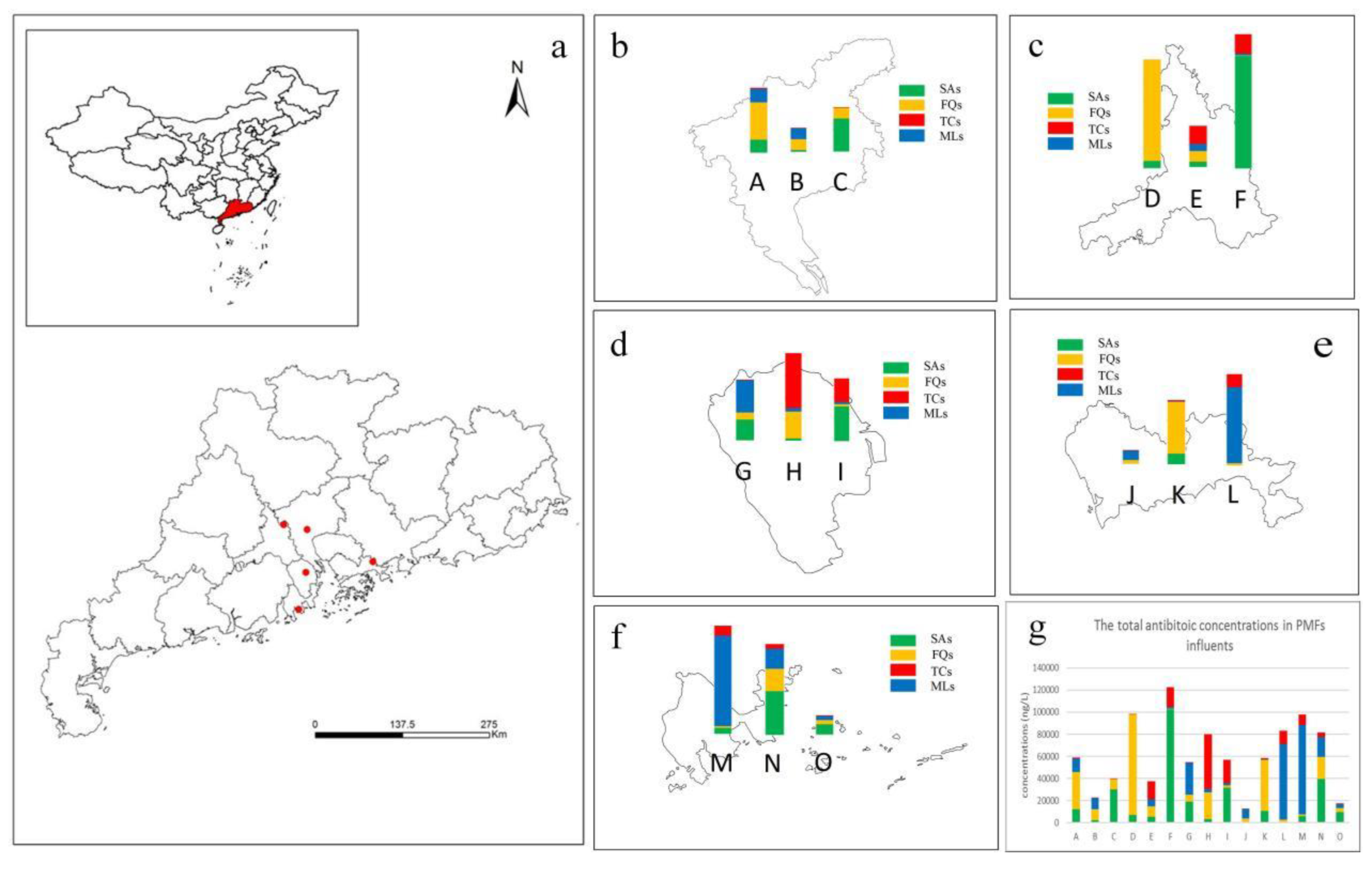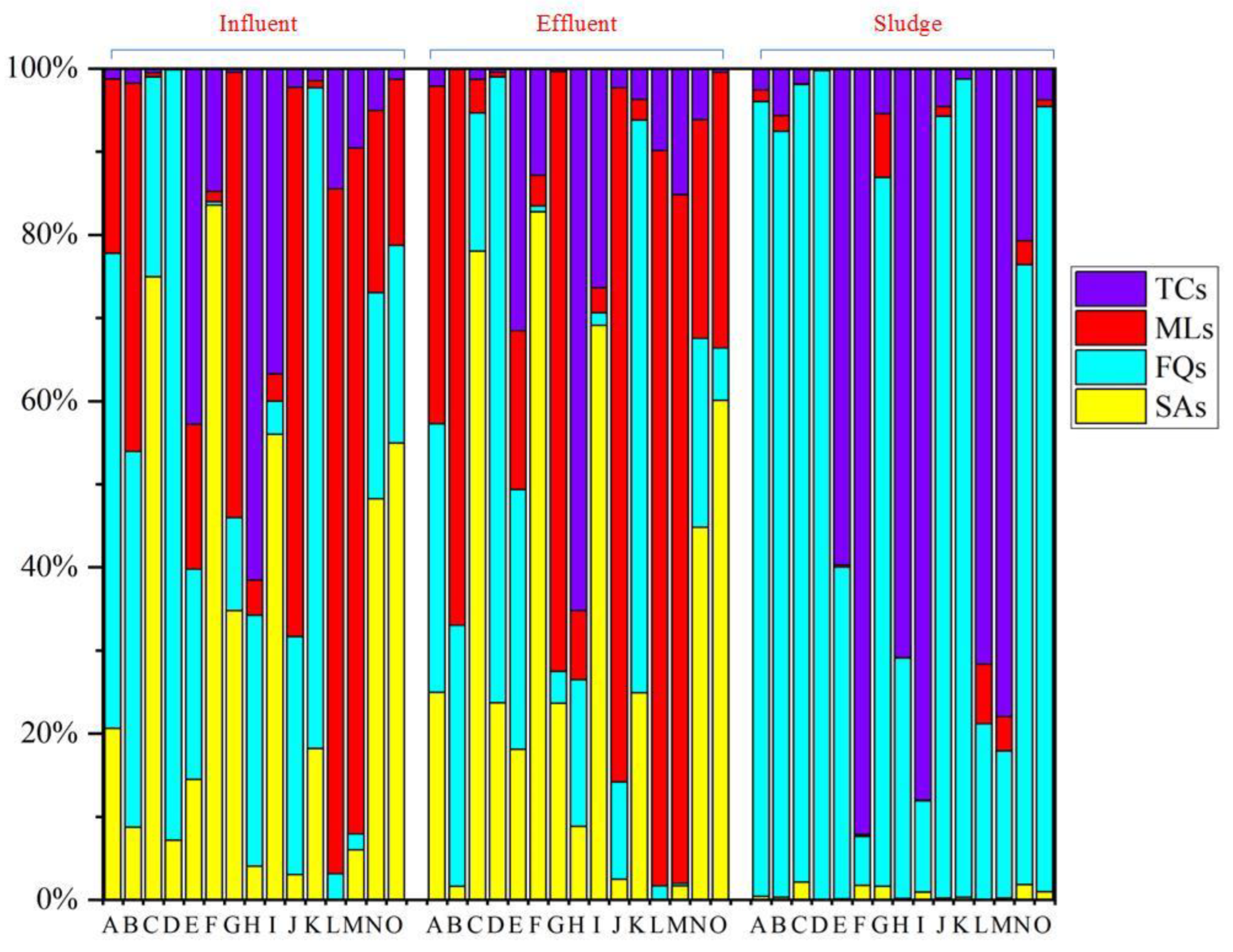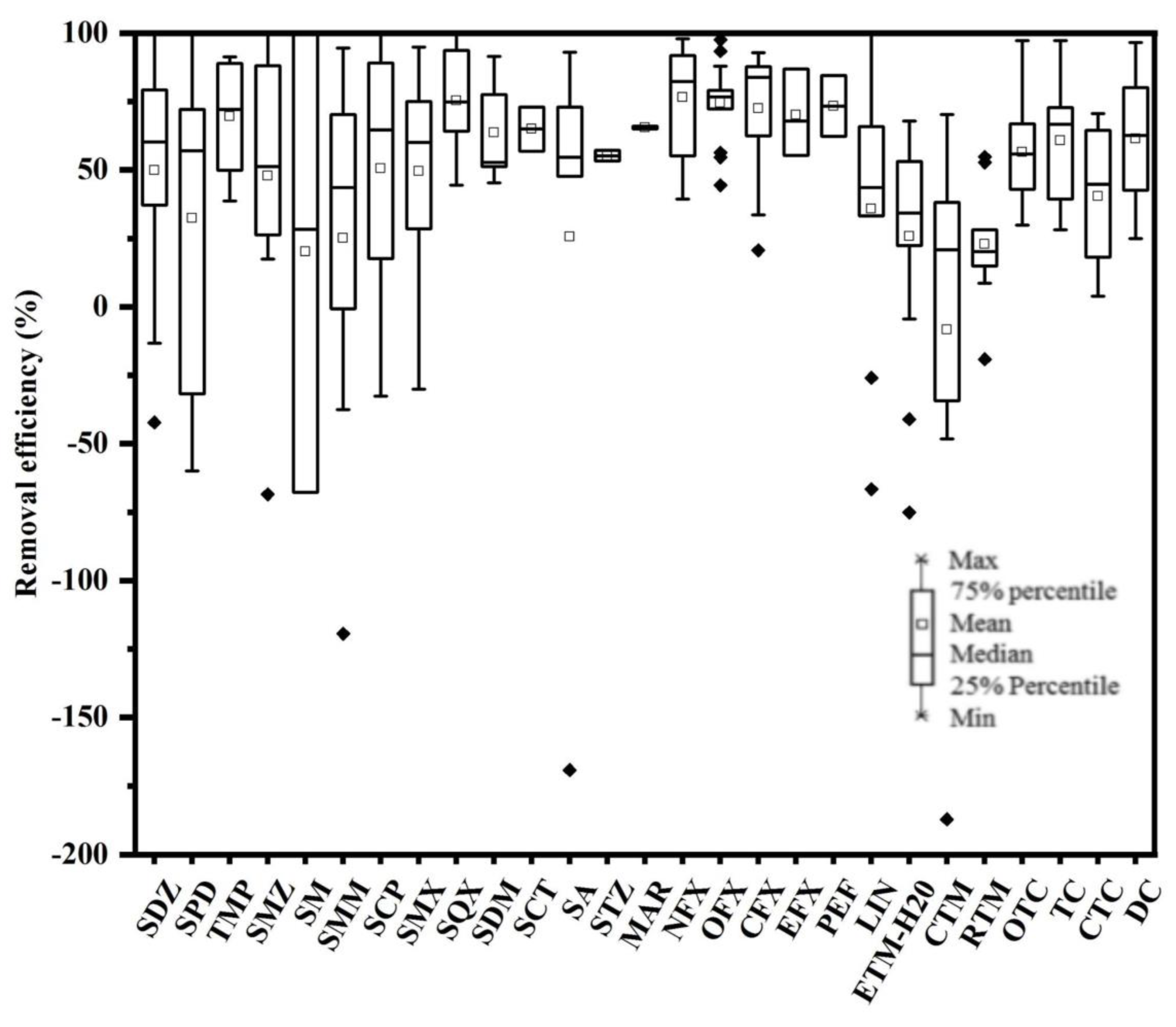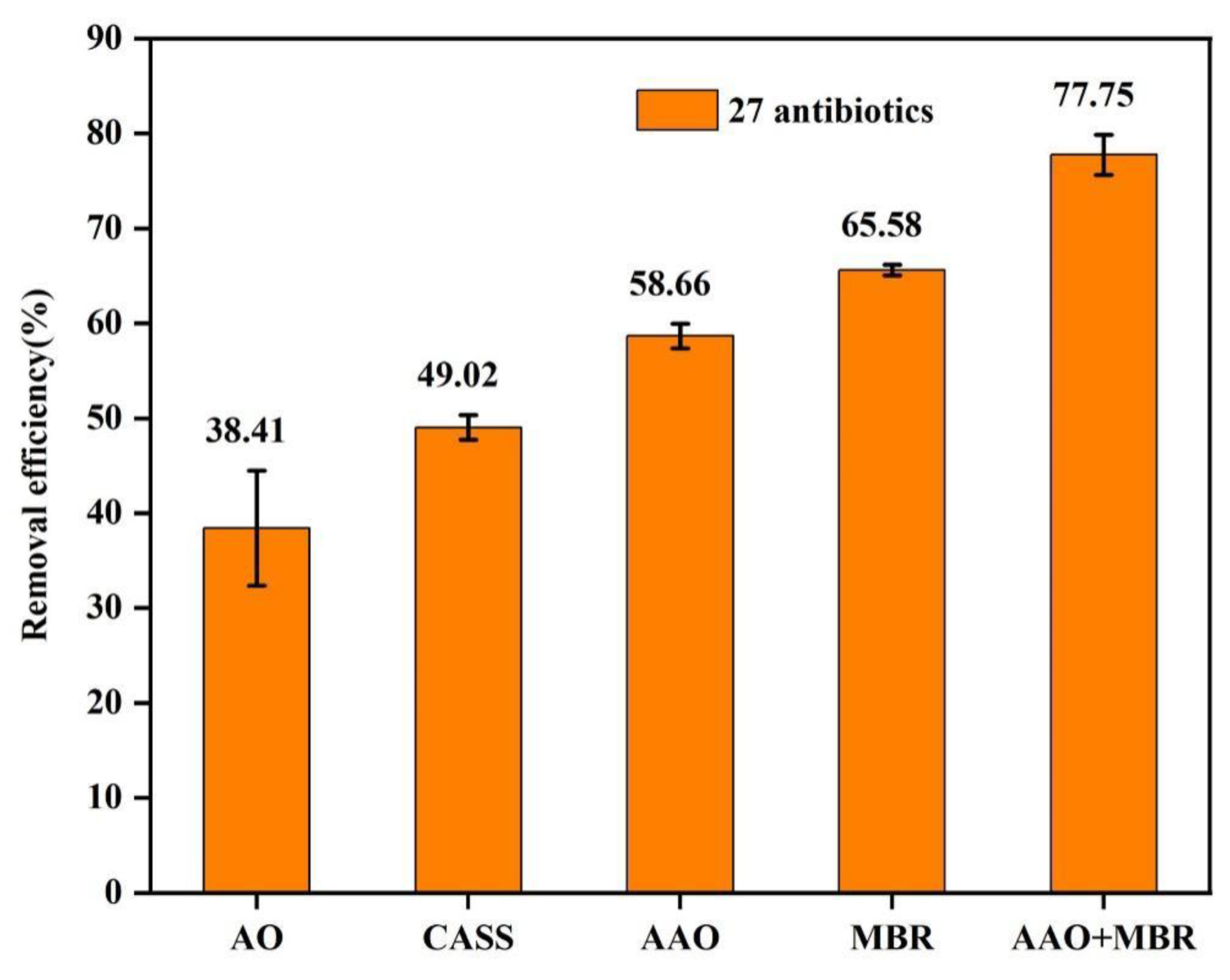Spatial Distribution and Risk Assessment of Antibiotics in 15 Pharmaceutical Plants in the Pearl River Delta
Abstract
1. Introduction
2. Materials and Methods
2.1. Regent and Materials
2.2. Sample Collection
2.3. Sample Preparation
2.4. Instrument Analysis
2.5. Ecological Risk Assessment
2.6. Quality Assurance and Quality Control (QA/QC)
2.7. Data Analysis
3. Results and Discussion
3.1. Occurrence and Concentration of Antibiotics in Wastewater Influents
3.2. Concentrations of Antibiotics in Pharmaceutical Plant Effluent and Excess Sludge
3.3. Aqueous Removal Efficiency of Antibiotics
3.4. Ecological Risk Assessment
4. Conclusions
Supplementary Materials
Author Contributions
Funding
Institutional Review Board Statement
Informed Consent Statement
Data Availability Statement
Acknowledgments
Conflicts of Interest
References
- Langbehn, R.K.; Michels, C.; Soares, H.M. Antibiotics in Wastewater: From Its Occurrence to the Biological Removal by Environmentally Conscious Technologies. Environ. Pollut. 2021, 275, 116603. [Google Scholar] [CrossRef] [PubMed]
- Zainab, S.M.; Junaid, M.; Xu, N.; Malik, R.N. Antibiotics and Antibiotic Resistant Genes (ARGs) in Groundwater: A Global Review on Dissemination, Sources, Interactions, Environmental and Human Health Risks. Water Res. 2020, 187, 116455. [Google Scholar] [CrossRef] [PubMed]
- Rodriguez-Mozaz, S.; Vaz-Moreira, I.; Varela Della Giustina, S.; Llorca, M.; Barceló, D.; Schubert, S.; Berendonk, T.U.; Michael-Kordatou, I.; Fatta-Kassinos, D.; Martinez, J.L.; et al. Antibiotic Residues in Final Effluents of European Wastewater Treatment Plants and Their Impact on the Aquatic Environment. Environ. Int. 2020, 140, 105733. [Google Scholar] [CrossRef] [PubMed]
- Menz, J.; Olsson, O.; Kümmerer, K. Antibiotic Residues in Livestock Manure: Does the EU Risk Assessment Sufficiently Protect against Microbial Toxicity and Selection of Resistant Bacteria in the Environment? J. Hazard. Mater. 2019, 379, 120807. [Google Scholar] [CrossRef]
- Wang, G.; Zhou, S.; Han, X.; Zhang, L.; Ding, S.; Li, Y.; Zhang, D.; Zarin, K. Occurrence, Distribution, and Source Track of Antibiotics and Antibiotic Resistance Genes in the Main Rivers of Chongqing City, Southwest China. J. Hazard. Mater. 2020, 389, 122110. [Google Scholar] [CrossRef]
- Cheng, D.; Ngo, H.H.; Guo, W.; Chang, S.W.; Nguyen, D.D.; Liu, Y.; Wei, Q.; Wei, D. A Critical Review on Antibiotics and Hormones in Swine Wastewater: Water Pollution Problems and Control Approaches. J. Hazard. Mater. 2020, 387, 121682. [Google Scholar] [CrossRef]
- Zhou, X.; Wang, J.; Lu, C.; Liao, Q.; Gudda, F.O.; Ling, W. Antibiotics in Animal Manure and Manure-Based Fertilizers: Occurrence and Ecological Risk Assessment. Chemosphere 2020, 255, 127006. [Google Scholar] [CrossRef]
- Lee, H.-J.; Kim, D.-W.; Chung, E.G. Strong Links between Load and Manure and a Comprehensive Risk Assessment of Veterinary Antibiotics with Low KOW in Intensive Livestock Farming Watersheds. Chemosphere 2021, 279, 130902. [Google Scholar] [CrossRef]
- Gao, F.-Z.; Zou, H.-Y.; Wu, D.-L.; Chen, S.; He, L.-Y.; Zhang, M.; Bai, H.; Ying, G.-G. Swine Farming Elevated the Proliferation of Acinetobacter with the Prevalence of Antibiotic Resistance Genes in the Groundwater. Environ. Int. 2020, 136, 105484. [Google Scholar] [CrossRef]
- WHO. WHO Global Report on Surveillance 2014. WHO 2014 AMR Rep. 2014, 1–8. [Google Scholar]
- Rathi, B.S.; Kumar, P.S.; Show, P.L. A Review on Effective Removal of Emerging Contaminants from Aquatic Systems: Current Trends and Scope for Further Research. J. Hazard. Mater. 2021, 409, 124413. [Google Scholar] [CrossRef] [PubMed]
- Zhang, Q.Q.; Ying, G.G.; Pan, C.G.; Liu, Y.S.; Zhao, J.L. Comprehensive Evaluation of Antibiotics Emission and Fate in the River Basins of China: Source Analysis, Multimedia Modeling, and Linkage to Bacterial Resistance. Environ. Sci. Technol. 2015, 49, 6772–6782. [Google Scholar] [CrossRef] [PubMed]
- Liu, X.; Zhang, G.; Liu, Y.; Lu, S.; Qin, P.; Guo, X.; Bi, B.; Wang, L.; Xi, B.; Wu, F.; et al. Occurrence and Fate of Antibiotics and Antibiotic Resistance Genes in Typical Urban Water of Beijing, China. Environ. Pollut. 2019, 246, 163–173. [Google Scholar] [CrossRef] [PubMed]
- Mirzaei, R.; Mesdaghinia, A.; Hoseini, S.S.; Yunesian, M. Antibiotics in Urban Wastewater and Rivers of Tehran, Iran: Consumption, Mass Load, Occurrence, and Ecological Risk. Chemosphere 2019, 221, 55–66. [Google Scholar] [CrossRef]
- Szymańska, U.; Wiergowski, M.; Sołtyszewski, I.; Kuzemko, J.; Wiergowska, G.; Woźniak, M.K. Presence of Antibiotics in the Aquatic Environment in Europe and Their Analytical Monitoring: Recent Trends and Perspectives. Microchem. J. 2019, 147, 729–740. [Google Scholar] [CrossRef]
- Cycoń, M.; Mrozik, A.; Piotrowska-Seget, Z. Antibiotics in the Soil Environment—Degradation and Their Impact on Microbial Activity and Diversity. Front. Microbiol. 2019, 10. [Google Scholar] [CrossRef]
- Li, F.; Chen, L.; Chen, W.; Bao, Y.; Zheng, Y.; Huang, B.; Mu, Q.; Wen, D.; Feng, C. Antibiotics in Coastal Water and Sediments of the East China Sea: Distribution, Ecological Risk Assessment and Indicators Screening. Mar. Pollut. Bull. 2020, 151, 110810. [Google Scholar] [CrossRef]
- Barbosa, M.O.; Moreira, N.F.F.; Ribeiro, A.R.; Pereira, M.F.R.; Silva, A.M.T. Occurrence and Removal of Organic Micropollutants: An Overview of the Watch List of EU Decision 2015/495. Water Res. 2016, 94, 257–279. [Google Scholar] [CrossRef]
- Kümmerer, K. Antibiotics in the Aquatic Environment—A Review-Part II. Chemosphere 2009, 75, 435–441. [Google Scholar] [CrossRef]
- Sim, W.J.; Lee, J.W.; Lee, E.S.; Shin, S.K.; Hwang, S.R.; Oh, J.E. Occurrence and Distribution of Pharmaceuticals in Wastewater from Households, Livestock Farms, Hospitals and Pharmaceutical Manufactures. Chemosphere 2011, 82, 179–186. [Google Scholar] [CrossRef]
- Wang, R.; Ji, M.; Zhai, H.; Guo, Y.; Liu, Y. Occurrence of Antibiotics and Antibiotic Resistance Genes in WWTP Effluent-Receiving Water Bodies and Reclaimed Wastewater Treatment Plants. Sci. Total Environ. 2021, 796, 148919. [Google Scholar] [CrossRef]
- Wang, K.; Zhuang, T.; Su, Z.; Chi, M.; Wang, H. Antibiotic Residues in Wastewaters from Sewage Treatment Plants and Pharmaceutical Industries: Occurrence, Removal and Environmental Impacts. Sci. Total Environ. 2021, 788, 147811. [Google Scholar] [CrossRef] [PubMed]
- Qiu, W.; Sun, J.; Fang, M.; Luo, S.; Tian, Y.; Dong, P.; Xu, B.; Zheng, C. Occurrence of Antibiotics in the Main Rivers of Shenzhen, China: Association with Antibiotic Resistance Genes and Microbial Community. Sci. Total Environ. 2019, 653, 334–341. [Google Scholar] [CrossRef] [PubMed]
- Larsson, D.G.J. Pollution from Drug Manufacturing: Review and Perspectives. Philos. Trans. R. Soc. B Biol. Sci. 2014, 369. [Google Scholar] [CrossRef]
- Bielen, A.; Šimatović, A.; Kosić-Vukšić, J.; Senta, I.; Ahel, M.; Babić, S.; Jurina, T.; González Plaza, J.J.; Milaković, M.; Udiković-Kolić, N. Negative Environmental Impacts of Antibiotic-Contaminated Effluents from Pharmaceutical Industries. Water Res. 2017, 126, 79–87. [Google Scholar] [CrossRef] [PubMed]
- Liu, Y.; Cai, D.; Li, X.; Wu, Q.; Ding, P.; Shen, L.; Yang, J.; Hu, G.; Wu, J.; Zhang, L. Occurrence, Fate, and Risk Assessment of Antibiotics in Typical Pharmaceutical Manufactories and Receiving Water Bodies from Different Regions. PLoS ONE 2023, 18, e0270945. [Google Scholar] [CrossRef]
- Thai, P.K.; Ky, L.X.; Binh, V.N.; Nhung, P.H.; Nhan, P.T.; Hieu, N.Q.; Dang, N.T.T.; Tam, N.K.B.; Anh, N.T.K. Occurrence of Antibiotic Residues and Antibiotic-Resistant Bacteria in Effluents of Pharmaceutical Manufacturers and Other Sources around Hanoi, Vietnam. Sci. Total Environ. 2018, 645, 393–400. [Google Scholar] [CrossRef]
- Hou, J.; Chen, Z.; Gao, J.; Xie, Y.; Li, L.; Qin, S.; Wang, Q.; Mao, D.; Luo, Y. Simultaneous Removal of Antibiotics and Antibiotic Resistance Genes from Pharmaceutical Wastewater Using the Combinations of Up-Flow Anaerobic Sludge Bed, Anoxic-Oxic Tank, and Advanced Oxidation Technologies. Water Res. 2019, 159, 511–520. [Google Scholar] [CrossRef]
- Liu, H.Q.; Lam, J.C.W.; Li, W.W.; Yu, H.Q.; Lam, P.K.S. Spatial Distribution and Removal Performance of Pharmaceuticals in Municipal Wastewater Treatment Plants in China. Sci. Total Environ. 2017, 586, 1162–1169. [Google Scholar] [CrossRef]
- Sun, C.; Hu, E.; Liu, S.; Wen, L.; Yang, F.; Li, M. Spatial Distribution and Risk Assessment of Certain Antibiotics in 51 Urban Wastewater Treatment Plants in the Transition Zone between North and South China. J. Hazard. Mater. 2022, 437, 129307. [Google Scholar] [CrossRef]
- Cardoso, O.; Porcher, J.M.; Sanchez, W. Factory-Discharged Pharmaceuticals Could Be a Relevant Source of Aquatic Environment Contamination: Review of Evidence and Need for Knowledge. Chemosphere 2014, 115, 20–30. [Google Scholar] [CrossRef] [PubMed]
- Zhou, L.J.; Ying, G.G.; Liu, S.; Zhao, J.L.; Yang, B.; Chen, Z.F.; Lai, H.J. Occurrence and Fate of Eleven Classes of Antibiotics in Two Typical Wastewater Treatment Plants in South China. Sci. Total Environ. 2013, 452–453, 365–376. [Google Scholar] [CrossRef] [PubMed]
- Wang, W.; Zhang, W.; Liang, H.; Gao, D. Occurrence and Fate of Typical Antibiotics in Wastewater Treatment Plants in Harbin, North-East China. Front. Environ. Sci. Eng. 2019, 13. [Google Scholar] [CrossRef]
- Tran, N.H.; Gan, J.; Nguyen, V.T.; Chen, H.; You, L.; Duarah, A.; Zhang, L.; Gin, K.Y.H. Sorption and Biodegradation of Artificial Sweeteners in Activated Sludge Processes. Bioresour. Technol. 2015, 197, 329–338. [Google Scholar] [CrossRef]
- Yang, S.F.; Lin, C.F.; Yu-Chen Lin, A.; Andy Hong, P.K. Sorption and Biodegradation of Sulfonamide Antibiotics by Activated Sludge: Experimental Assessment Using Batch Data Obtained under Aerobic Conditions. Water Res. 2011, 45, 3389–3397. [Google Scholar] [CrossRef]
- Sabri, N.A.; van Holst, S.; Schmitt, H.; van der Zaan, B.M.; Gerritsen, H.W.; Rijnaarts, H.H.M.; Langenhoff, A.A.M. Fate of Antibiotics and Antibiotic Resistance Genes during Conventional and Additional Treatment Technologies in Wastewater Treatment Plants. Sci. Total Environ. 2020, 741, 140199. [Google Scholar] [CrossRef]
- Phoon, B.L.; Ong, C.C.; Mohamed Saheed, M.S.; Show, P.L.; Chang, J.S.; Ling, T.C.; Lam, S.S.; Juan, J.C. Conventional and Emerging Technologies for Removal of Antibiotics from Wastewater. J. Hazard. Mater. 2020, 400, 122961. [Google Scholar] [CrossRef]
- Jia, A.; Wan, Y.; Xiao, Y.; Hu, J. Occurrence and Fate of Quinolone and Fluoroquinolone Antibiotics in a Municipal Sewage Treatment Plant. Water Res. 2012, 46, 387–394. [Google Scholar] [CrossRef]
- Krzeminski, P.; Tomei, M.C.; Karaolia, P.; Langenhoff, A.; Almeida, C.M.R.; Felis, E.; Gritten, F.; Andersen, H.R.; Fernandes, T.; Manaia, C.M.; et al. Performance of Secondary Wastewater Treatment Methods for the Removal of Contaminants of Emerging Concern Implicated in Crop Uptake and Antibiotic Resistance Spread: A Review. Sci. Total Environ. 2019, 648, 1052–1081. [Google Scholar] [CrossRef]
- Jelic, A.; Gros, M.; Ginebreda, A.; Cespedes-Sánchez, R.; Ventura, F.; Petrovic, M.; Barcelo, D. Occurrence, Partition and Removal of Pharmaceuticals in Sewage Water and Sludge during Wastewater Treatment. Water Res. 2011, 45, 1165–1176. [Google Scholar] [CrossRef]
- Xue, W.; Zhou, Q.; Li, F. Bacterial Community Changes and Antibiotic Resistance Gene Quantification in Microbial Electrolysis Cells during Long-Term Sulfamethoxazole Treatment. Bioresour. Technol. 2019, 294, 122170. [Google Scholar] [CrossRef] [PubMed]
- Luo, Q.; Gu, L.; Wu, Z.; Shan, Y.; Wang, H.; Sun, L. Distribution, Source Apportionment and Ecological Risks of Organophosphate Esters in Surface Sediments from the Liao River, Northeast China. Chemosphere 2020, 250, 126297. [Google Scholar] [CrossRef] [PubMed]
- Zhang, R.; Tang, J.; Li, J.; Zheng, Q.; Liu, D.; Chen, Y.; Zou, Y.; Chen, X.; Luo, C.; Zhang, G. Antibiotics in the Offshore Waters of the Bohai Sea and the Yellow Sea in China: Occurrence, Distribution and Ecological Risks. Environ. Pollut. 2013, 174, 71–77. [Google Scholar] [CrossRef] [PubMed]






| Sample Point | Location | Average Daily Flow (m3 Day−1) | Antibiotic Products | Treatment Process |
|---|---|---|---|---|
| Pharmaceutical plant A | Guangzhou | 500 | SAs, QLs, MLs | MBR a |
| Pharmaceutical plant B | Guangzhou | 600 | QLs, MLs | CASS b |
| Pharmaceutical plant C | Guangzhou | 400 | SAs, QLs | AAO + MBR c |
| Pharmaceutical plant D | Shenzhen | 800 | SAs, QLs | AAO + MBR |
| Pharmaceutical plant E | Shenzhen | 600 | QLs, TCs | AAO d |
| Pharmaceutical plant F | Shenzhen | 1200 | SAs, TCs | MBR |
| Pharmaceutical plant G | Foshan | 400 | SAs, MLs | AO e |
| Pharmaceutical plant H | Foshan | 600 | QLs, TCs | AAO |
| Pharmaceutical plant I | Foshan | 500 | SAs, TCs | AO |
| Pharmaceutical plant J | Zhongshan | 500 | QLs, MLs | CASS |
| Pharmaceutical plant K | Zhongshan | 600 | SAs, QLs | AAO + MBR |
| Pharmaceutical plant L | Zhongshan | 400 | MLs, TCs | CASS |
| Pharmaceutical plant M | Zhuhai | 600 | SAs, MLs, TCs | MBR |
| Pharmaceutical plant N | Zhuhai | 700 | SAs, QLs, MLs, TCs | AAO |
| Pharmaceutical plant O | Zhuhai | 600 | SAs, QLs, MLs | AO |
| Compound | Influent (ng/L, n = 15) | Effluent (ng/L, n = 15) | Excess Sludge (ng/g, n = 15) | |||||||||
|---|---|---|---|---|---|---|---|---|---|---|---|---|
| Range | Mean | Median | Freq (%) | Range | Mean | Median | Freq (%) | Range | Mean | Median | Freq (%) | |
| SDZ 1 | <0.35–4269.31 | 671.31 | 215.61 | 87 | <0.44–2896.32 | 375.34 | 102.62 | 80 | <0.74–78.21 | 12.65 | 5.62 | 80 |
| SPD 2 | <0.38–1235.91 | 117.46 | <0.38 | 40 | <0.64–554.82 | 70.15 | <0.64 | 33 | <1.24–24.61 | 2.83 | <1.24 | 33 |
| TMP 3 | <1.58–5681.12 | 1095.62 | 204.64 | 73 | <0.45–1245.32 | 305.09 | 56.91 | 73 | <0.94–145.32 | 30.26 | 7.92 | 73 |
| SMZ 4 | <2.43–59,825.12 | 7121.21 | 102.32 | 73 | <2.32–23,564.32 | 3185.55 | 72.31 | 67 | <3.61–356.22 | 52.36 | 4.31 | 67 |
| SM 5 | <1.36–2489.52 | 173.24 | <1.36 | 20 | <1.58–1786.61 | 126.86 | <1.58 | 13 | <2.98–48.92 | 3.59 | <2.98 | 20 |
| SMM 6 | <2.4–3895.67 | 619.14 | 83.65 | 53 | <12.3–2489.62 | 406.56 | 4.61 | 53 | <4.8–45.71 | 8.29 | 2.61 | 53 |
| SCP 7 | <5.6–5968.32 | 1075.22 | <5.6 | 40 | <5.6–3489.42 | 416.31 | <5.6 | 33 | <6.4–123.62 | 18.41 | <6.4 | 33 |
| SMX 8 | <0.54–28,456.52 | 5338.95 | 2241.33 | 80 | <0.56–7156.32 | 1858.44 | 345.92 | 80 | <1.24–541.22 | 87.01 | 24.56 | 80 |
| SQX 9 | <0.25–1452.30 | 154.04 | <0.25 | 40 | <1.59–325.61 | 38.18 | <1.59 | 33 | <0.55–24.36 | 2.89 | <0.55 | 40 |
| SDM 10 | <0.58–4756.21 | 830.15 | <0.58 | 33 | <0.84–2248.91 | 356.62 | <0.84 | 33 | <0.94–104.22 | 18.71 | <0.94 | 33 |
| SCT 11 | <3.2–569.31 | 40.33 | <3.2 | 13 | <2.46–245.32 | 16.99 | <2.46 | 13 | <3.42–8.32 | 0.64 | <3.42 | 13 |
| SA 12 | <0.96–5789.32 | 1125.91 | <0.96 | 40 | <8.6–2036.51 | 452.05 | <8.6 | 40 | <1.89–58.42 | 10.73 | <1.89 | 40 |
| STZ 13 | <1.24–2875.69 | 195.46 | <1.24 | 13 | <1.21–1233.51 | 83.99 | <1.21 | 13 | <1.57–54.32 | 3.72 | <1.57 | 13 |
| ΣSAs | 26.91–102,413.82 | 18,557.77 | 9366.81 | NA | 5.61–35,732.22 | 7692.11 | 4192.12 | NA | 2.32–936.06 | 252.11 | 171.45 | NA |
| MAR 14 | <2.4–2563.31 | 184.46 | <2.4 | 13 | <3.4–895.61 | 64.33 | <3.4 | 13 | <4.8–5485.22 | 397.57 | <4.8 | 13 |
| NFX 15 | <0.61–52,302.91 | 6523.78 | 1058.92 | 100 | <4.8–6339.81 | 1186.23 | 245.32 | 100 | <6.4–57,824.11 | 8853.54 | 3256.22 | 100 |
| OFL 16 | <0.54–28,548.22 | 5140.45 | 2489.22 | 93 | <0.68–7452.31 | 1457.44 | 556.32 | 93 | <1.24–34,582.22 | 9096.35 | 4789.61 | 93 |
| CIP 17 | <3.4–28,756.52 | 4093.42 | 1025.31 | 80 | <2.8–4782.31 | 810.69 | 163.22 | 80 | <5.6–30,452.11 | 6306.53 | 2456.11 | 80 |
| EFX 18 | <2.9–3489.22 | 359.98 | <2.9 | 20 | <3.4–556.92 | 81.83 | <3.4 | 20 | <4.2–6893.22 | 812.72 | <4.2 | 20 |
| PEF 19 | <0.25–18,569.23 | 1396.51 | <0.25 | 13 | <0.47–2890.32 | 252.45 | <0.47 | 13 | <0.55–21,563.42 | 1876.31 | <0.55 | 13 |
| ΣFQs | 519.22–90,941.42 | 17,698.59 | 9408.22 | NA | 107.72 | 3852.97 | 1597.92 | NA | 2262.54–125,761 | 27,343.01 | 21,737.8 | NA |
| LIN 20 | <1.45–56,258.34 | 7671.45 | 208.91 | 67 | <2.8–30,256.31 | 3752.13 | 104.61 | 60 | <3.42–1025.31 | 158.59 | 14.51 | 67 |
| ETM-H2O 21 | <0.89–38,952.31 | 5349.97 | 2545.31 | 93 | <0.79–12,489.12 | 2657.29 | 1820.51 | 93 | <1.45–689.22 | 153.18 | 51.32 | 93 |
| CTM 22 | <0.69–12,895.52 | 1866.36 | 12.64 | 53 | <0.94–7105.62 | 1282.31 | 36.22 | 53 | <2.52–569.32 | 68.33 | 5.41 | 53 |
| RTM 23 | <0.58–4756.52 | 1405.83 | 609.62 | 60 | <0.68–3489.32 | 1025.49 | 452.51 | 60 | <0.94–785.33 | 117.28 | 14.31 | 60 |
| ΣMLs | 61.54–80,628.52 | 16,293.61 | 6489.51 | NA | 102.52–38,589.22 | 8717.22 | 4166.14 | NA | 3.64–2108.04 | 497.39 | 124.32 | NA |
| OTC 24 | <3.2–38,456.22 | 4995.49 | 549.50 | 67 | <4.2–15,289.32 | 2021.55 | 278.22 | 67 | <3.42–45,789.32 | 8314.19 | 785.62 | 67 |
| TC 25 | <0.96–15,463.52 | 3291.25 | 536.22 | 67 | <2.14–5124.62 | 1185.57 | 356.22 | 67 | <1.89–31,458.22 | 6397.82 | 879.22 | 67 |
| CTC 26 | <1.24–2896.51 | 321.09 | <1.24 | 33 | <1.08–2369.51 | 210.81 | <1.08 | 33 | <1.57–5489.24 | 727.63 | <1.57 | 33 |
| DC 27 | <3.7–1356.32 | 257.43 | 104.56 | 53 | <4.9–552.91 | 87.31 | 6.42 | 53 | <4.2–3452.32 | 579.41 | 320.32 | 53 |
| ΣTCs | 104.56–49,398.11 | 8865.27 | 861.01 | NA | 11.34–20,859.53 | 3505.25 | 535.42 | NA | 320.34–68,955.92 | 16,019.05 | 1331.52 | NA |
Disclaimer/Publisher’s Note: The statements, opinions and data contained in all publications are solely those of the individual author(s) and contributor(s) and not of MDPI and/or the editor(s). MDPI and/or the editor(s) disclaim responsibility for any injury to people or property resulting from any ideas, methods, instructions or products referred to in the content. |
© 2023 by the authors. Licensee MDPI, Basel, Switzerland. This article is an open access article distributed under the terms and conditions of the Creative Commons Attribution (CC BY) license (https://creativecommons.org/licenses/by/4.0/).
Share and Cite
Liu, Y.; Shi, X.; Chen, X.; Ding, P.; Zhang, L.; Yang, J.; Pan, J.; Yu, Y.; Wu, J.; Hu, G. Spatial Distribution and Risk Assessment of Antibiotics in 15 Pharmaceutical Plants in the Pearl River Delta. Toxics 2023, 11, 382. https://doi.org/10.3390/toxics11040382
Liu Y, Shi X, Chen X, Ding P, Zhang L, Yang J, Pan J, Yu Y, Wu J, Hu G. Spatial Distribution and Risk Assessment of Antibiotics in 15 Pharmaceutical Plants in the Pearl River Delta. Toxics. 2023; 11(4):382. https://doi.org/10.3390/toxics11040382
Chicago/Turabian StyleLiu, Yuanfei, Xiaoxia Shi, Xiaoxia Chen, Ping Ding, Lijuan Zhang, Jian Yang, Jun Pan, Yunjiang Yu, Jinhua Wu, and Guocheng Hu. 2023. "Spatial Distribution and Risk Assessment of Antibiotics in 15 Pharmaceutical Plants in the Pearl River Delta" Toxics 11, no. 4: 382. https://doi.org/10.3390/toxics11040382
APA StyleLiu, Y., Shi, X., Chen, X., Ding, P., Zhang, L., Yang, J., Pan, J., Yu, Y., Wu, J., & Hu, G. (2023). Spatial Distribution and Risk Assessment of Antibiotics in 15 Pharmaceutical Plants in the Pearl River Delta. Toxics, 11(4), 382. https://doi.org/10.3390/toxics11040382






